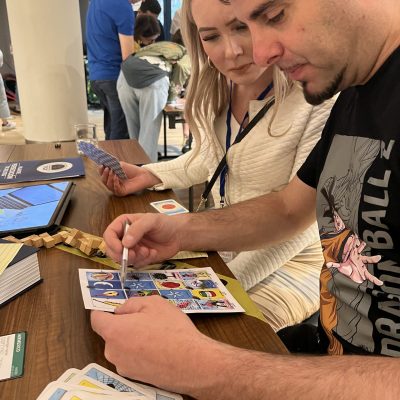Decision-making skills come up countless times every day in the workplace. From minor choices about what to say to a client in an email to major ones like how to approach a big project that impacts your organization’s future, there are always choices to be made.
We discussed decision-making and its intrinsic connection to storytelling on our podcast episode—The Strategic Art of Business Storytelling—with Robert Mattson, founder of INTRIGUE Communication & Coaching.
Today, we’re going to explore the ins and outs of decision-making, how your unconscious mind comes into play, and the relationship between decision-making and storytelling.
The Role of the Unconscious Mind in Decision-Making Skills
You know you make decisions every day, both in and out of the workplace. But what many people don’t realize is how big of a role our unconscious minds play in this process.
According to Robert Mattson, 95% of our decisions actually happen in the unconscious mind. As Robert notes, “The 95% figure comes from Dr. Gerald Altman from Harvard, who quantified the old saying, ‘People buy emotionally and justify with facts.’”
This statistic reveals why improving our decision-making skills requires more than just logic—you have to understand the powerful interplay between emotions, storytelling, and unconscious mental patterns.
Everything moves fast in today’s business environment, and this means that good decision-making skills aren’t just helpful—they’re essential.
We’re not just using the old “in today’s world” line because it sounds good here, either. According to a 2023 global study by Oracle, 74% of people say that the number of decisions they make every day has increased 10x over the past three years.
The Psychology of Decision-Making Skills
Understanding the psychology behind how the human brain chooses things can dramatically improve your decision-making strategies.
The science behind decision-making skills reveals that our brains don’t function like the rational computers we’d sometimes imagine them to be.
Logic vs Emotion: A Case Study
Robert emphasizes that the majority of our decisions happen beneath conscious awareness—they’re shaped by the stories we’ve internalized and the experiences we’ve accumulated.
In our podcast episode, Robert offered a compelling example of this point:
“In 2022, there were 160,000 minivans sold in the U.S. compared to 6 million SUVs. Is that because minivans don’t do the job as well as SUVs? No. In fact, they often do the job a lot better than SUVs.
“The thing is that people emotionally think, ‘I don’t want to be a minivan person.’ They want to be the SUV person because that’s ‘cooler.'”
In the example above, those who bought SUVs might have listened to the logical points of car salesmen to justify avoiding “minivan person” status. Or maybe they looked up the benefits of an SUV after driving one home to justify their purchase after the fact.
Regardless, Robert’s example does a great job of showing how unconscious feelings can drive decisions and how we often justify this with logical reasons.
Two Levels of Decision-Making: Emotional vs Rational
Decision-making operates on two distinct levels:
- Emotional decision-making engages our limbic system—your emotional nervous system—to drive quick, intuitive responses based on feelings instead of facts.
- Rational decision-making activates our prefrontal cortex—your brain’s center of logic and self-control—enabling logical reasoning and methodical analysis to make choices based on fact and reason.
Most assume that their personal decision-making strategy is mostly rational thought and with minimal emotional weight. However, their emotions and connection to the topic and the stories they’ve heard can have immense unconscious influence over this process.
The Power of Stories in Shaping Decisions
The stories we tell ourselves and others have the power to change what we think is logical, tap into things we dislike or fear, and subconsciously change the choices we’re likely to make.
“You’re wired to learn by stories,” Robert explains. “Stories are 22 times more memorable than features, facts, and functions alone.
“I tell people you don’t want to win the hour you’re talking to someone; you want to win the five minutes after you leave the room. Are they talking about the things you want them to talk about? Stories help you remember.”
Unfortunately, most leaders, HR staff, marketers, and salespeople focus on cold, stale facts to try to influence people. If they do use stories, they’re just a garnish to try to loosen up the crowd.
Commenting on this, Robert said, “I work with people to integrate stories to intrigue, persuade, and be memorable.”
When to Use Team Decision-Making in the Workplace
Not every decision requires gathering the entire team. Knowing when to rely on personal decision-making strategies versus team decision-making at work can save valuable time and resources.
Similarly, sometimes you only need to involve a small group of people in a decision instead of everyone on the team.
When one or two people have the necessary expertise to make the decision, it doesn’t always make sense to involve the whole team. This tends to work best when you’ve built a lot of trust within your organization.
Individual and small-group decision-making skills work best for:
- Areas where one or two people have specific expertise
- Routine matters that require quick choices with minimal risk
- Decisions that don’t impact most of the team or organization
- Situations requiring confidentiality
Team decision-making skills tend to shine when:
- Complex problems require input from diverse perspectives
- Implementation will rely on organizational support and buy-in
- Innovation that calls for creative input
- High-stakes situations that impact people at every level of the organization
Group cohesion and consensus can subconsciously become more important to people than reaching the right decision in some situations.
These factors encourage leaders to make decisions that require enthusiastic commitment without team input, which may derail the success of your organization. To determine which approach is appropriate, ask yourself:
- Does the decision have an impact on multiple departments?
- Will implementation require cross-departmental cooperation?
- Do you need an innovative solution?
- Could diverse perspectives significantly improve the outcome?
- Is broad ownership and acceptance of the decision important for success?
If the answer is “yes” to any of these questions, consider team decision-making strategies.
Key Strategies for Successful Decision-Making at Work
Organizational decision-making should employ frameworks designed to balance our emotional intelligence with analytical thinking processes.
It’s all about taking a systematic approach to considering your options and evaluation criteria. By weighing each option against each criterion, you can bring clarity to complex decisions.
For example, say you’re trying to pick a potential new office location. In this case, you might weigh each one against criteria like cost, average commute time, amenities, and growth potential. Bonus points if you do this as a team.
How to Present Decisions Using Frameworks and Storytelling
When presenting decisions to team members, it often comes down to understanding your audience and their attention span.
Robert recommends a framework he calls the 33 rule:
“You have approximately 33 seconds to grab people’s attention, and then you have to re-engage every three minutes.”
You can apply the 33 rule by placing your most attention-grabbing hook in the first 33 seconds and creating moments designed specifically to maintain attention every three minutes.
For storytelling, Robert advises people to remember that most audiences have at least a little bit of each of these three traits:
- Selfish: They want something out of this discussion because they’re investing their valuable time and attention.
- Lazy: No one wants to do a bunch of math and research—they want you to tell them what’s important.
- Smug: Many people assume you have an agenda, especially if you’re in sales, and you have to show them the importance of what you’re presenting.
By keeping these traits in mind as you develop the story surrounding your decision, you tap into the emotional aspect—the unconscious 95%—of decision-making.
How To Improve Team Decision-Making
Leadership can be challenging, but as a leader, you have a responsibility to your team and your business.
If you want your team to learn how to make a decision with efficiency and logic, it’s important to start with a solid foundation and lead by example.
The most basic foundational element to focus on is creating psychological safety in the workplace. When team members feel safe expressing different views or disagreeing without fear of judgment or reprisal, the quality of decisions dramatically improves.
Focus on creating an environment where your teams can express themselves without fear and weave this principle into your company culture. You can help this along by modeling certain behaviors:
- Vulnerability
- Acknowledging when you are wrong or uncertain
- Valuing and rewarding diverse perspectives
Leading by example and adopting just these three behaviors can go a long way in showing people that they don’t have to be afraid when they share their thoughts.
Decision-Making Skills and Tricks To Put Into Practice
On top of helping your team feel safe, you’ll be setting an example by improving your own decision-making skills alongside your team members.
Here are some skills and tricks to put into practice on your own and to start teaching your team:
Avoid Decision Fatigue
Decision fatigue refers to the deteriorating quality of decisions throughout the day or after a long session of decision-making.
To avoid this, try to schedule your most important decisions early in the day and group similar, less critical choices into a short time period later in the day.
By making decisions just twice a day and limiting how long you spend on them, you can reduce decision fatigue.
Practice Temporal Distancing
Temporal distancing refers to a mental distancing from the current situation into the past or future—in the case of decision-making skills, the future is usually best.
You can do this by asking, “What advice would I give myself about this one year from now?” before you make a decision. Then, pose the same question to your team.
Designate a Devil’s Advocate
Assign a new person in each meeting to challenge assumptions relating to every significant decision. This person will play the devil’s advocate, working to provoke debate and test the strength of decisions.
This practice also helps everyone feel more comfortable disagreeing by giving them experience and positive association with doing so.
Weigh Pros and Cons
For every significant decision, make a pros and cons list. Then, take it a step further by assigning “weights” or importance to each factor involved in your decision on a scale of 1 to 5.
For team decisions, make this a group activity and consider voting on the importance of each factor.
How to Improve Decision-Making Skills with Team Building Activities
It might be tempting to buy everyone a book on decision-making and call it a day, but that’s not going to cut it. In addition to leading by example and building a foundation of trust, you need to help your team members learn by doing.
Research shows that one of the best ways to improve any skill is hands-on experience, and decision-making is no different.
Team building activities that emphasize decision-making skills are one way to do this—they’ll help your team members learn to trust each other, communicate more efficiently, and so much more.
If this sounds like an approach you’d like to try with your team, check out some of our favorite team building programs designed to improve decision-making skills:
- TeamProv: Our Improv for Team Building program, TeamProv, teaches your team to focus, trust each other, and practice active listening—all crucial skills for effective decision-making under pressure.
- Catapult to Success: This one’s all about friendly competition and ingenuity as your teams design and build working catapults before testing them on the field, improving their decision-making and problem-solving skills along the way.
- Polaroid Scavenger Hunt: Enjoy a blast from the past with this fun scavenger hunt as your team explores the city using teamwork, strategy, and quick decision-making skills for unexpected challenges and hilarious snapshots.
- Corporate CSI: This interactive game provides the ultimate crime-solving experience; your team will rely on critical thinking, collaboration, communication, and quick decision-making skills as they race against the clock to crack the case.
Each of these programs engages your team members in an activity that helps them improve their decision-making skills. They’ll also get your team to have fun, strengthen connections between colleagues, and stave off the dreaded burnout. Everyone wins.
Improve Your Team’s Decision-Making Skills With TeamBonding
Effective decision-making is one of the most valuable skills in today’s workplaces, and every business can benefit from focusing on it.
By understanding the psychology behind our choices and developing related skills, you and your team can navigate even the most challenging of situations with greater confidence and success.
Not loving the team building programs we highlighted above? No problem! We have more than 200 programs in our team building catalog, and all of them can be customized to meet your needs. Contact us today to get started!

















